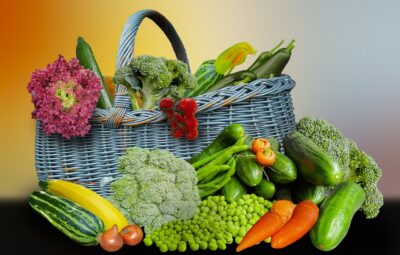A plant-based diet is becoming increasingly popular.
While it’s not the best approach for everyone, it’s better than the standard American diet. In the past few years, buzz-generating documentaries like What the Health, The Game Changers, and Cowspiracy have led to an explosion of plant-based awareness and curious newcomers to the plant-based community. Money talks, too — a report issued by the Plant-Based Food Association and Good Food Institute last year found that U.S. sales of plant-based foods increased by 11 percent, outgrowing other grocery categories by 5x.
“Plant-based diets are proven to have lasting health benefits and to create a more sustainable future for all.”
But plant-based diets are more than just a media or consumer craze. In fact, research on plant-based diets has been around for quite some time. In the 1980s, researchers embarked on the China Project, a decade-long study that examined the connection between nutrition and chronic health conditions like heart disease, diabetes, and cancer.
Since then, the American Cancer Society and the World Health Organization have published findings confirming the link between eating processed meats and cancers, while leading nutrition and food research experts have formally advocated in favor of plant-forward diets. Add to that growing concerns around the meat industry’s carbon footprint and the virality of news on social media, the case for plant-based has never been stronger.
But what is a plant-based diet, anyway? The term seems to mean different things to different people, and you’ll get varying explanations depending on who you ask. Let’s dive in.
What is a Plant-Based Diet?
If you’re not familiar with a plant-based diet, here’s a small summary. The diet is made up of whole plant-based foods such as fruits, vegetables, leafy greens, whole grains, nuts, seeds, and legumes such as beans, peas, and lentils.
Plant-based diets normally eliminate added sugars and free oils, but some may include healthier options of those ingredients on occasion. Many plant-based diets also allow the occasional use of cultured dairy products, organic eggs, or wild fish, but this is much less common.
Plant-based vs. vegan
Veganism is a lifestyle or dietary choice that eliminates the consumption of any and all animal products, typically rooted in an ethical desire to do no harm. While vegans do often adopt a whole foods plant based diet, whole-foods-plant-based and vegan mean different things, because vegan diets are not necessarily restricted to whole foods only. Therefore, a vegan might be open to consuming more processed foods (we’re looking at you, buffalo seitan wings) than somebody following a whole foods plant based diet.
Additionally, it’s worth noting that veganism eschews the use of animal products anywhere. Truly strict vegans will eliminate foods such as non-organic sugars and maple syrups from their diets, because these products are often processed using animal products (conventional sugar, for example, is bleached white using animal bone char). And beyond food, they’ll also avoid purchasing and wearing accessories made from leather and fur, because these products are made from animals.
What Are the Benefits of a Plant-Based Diet?
In short, plants are full of vitamins, minerals, and necessary macronutrients in the most pure form. Because they are made of whole foods, plants also provide more nutrition than most processed foods.
Load up on nutrients
Fiber and phytonutrients are critical for our health, and are found exclusively in plant foods. Fiber is crucial to the body’s digestive, cardiovascular, and immune systems, while phytonutrients have immunity-boosting effects that are shown to fight inflammation, slow cancer cell growth, and lower blood pressure.
In addition, plant foods provide nearly every essential nutrient the body needs: protein, omega-3 fats, calcium, iodine, iron, zinc, folate, Vitamin C, D, and K — you name it, plants have it. You may have heard people say that you should ‘eat the rainbow’, or put lots of different colors of food on your plate. That’s because foods of different colors tend to contain different types of nutrients. And plant-based foods are an amazing way to add color, beauty, and balanced nutrition to your table.
Improve your health
There’s strong scientific evidence that many chronic conditions can be controlled or even reversed by switching to a plant-based diet. For instance, a 2017 study found that eating plant-based significantly lowered blood pressure — so much so that researchers believe it’s the most effective intervention, especially when coupled with exercise and weight loss.
Maintain a healthy weight
Studies show that plant-based diets are associated with lower weights. That’s largely due to the fact that vegetables, fruits, whole grains, and legumes are a significant source of fiber, keeping you fuller longer, and preventing those unhealthy midday (or midnight) snack cravings. And, eating plant-based limits the amount of unhealthy saturated fats you might otherwise consume from meat, poultry, or processed foods.
The health benefits of eating plant-based are cyclical, and one benefit can often be directly linked to another. The perfect example: a lower body weight is typically associated with lower blood pressure; lower blood pressure equates to a healthier heart; and a stronger heart means lower risk of life-threatening conditions like heart disease, stroke, diabetes, and cancer.
Reduce your environmental impact
Eating more plants is good for the planet. Animal agriculture accounts for 25 percent of the world’s greenhouse gas emissions and contributes to the destruction of wildlife habitats to make way for livestock farms and arable land to feed them. Our water resources are impacted too: producing a single pound of animal protein requires 100 times more water than producing a pound of grain protein. And a gallon of milk? It requires 1,000 gallons of water. Collectively, animal agriculture uses up over half of the world’s freshwater supply.
According to some scientists, avoiding dairy products is the single biggest way to reduce your carbon footprint. While there’s debate within the scientific community around exactly how much animal agriculture contributes to global warming, especially compared to fossil fuel emissions, there’s one thing that’s for certain: limited or conscious consumption of animal products is a surefire step towards food sustainability — and that’s always a good thing.
OK, so plant-based eating is healthy. But how can you be sure that you’ll get all the vital nutrients essential for keeping your body strong — protein, especially? Let’s get into the details!
PLANT-BASED NUTRIENTS
Macronutrients are essential nutrients the body needs in larger quantities to stay fueled and healthy. Scientists and nutritionists recommend that any healthy diet incorporate the three main macronutrients: proteins, carbohydrates, fat. Each one provides the body with unique nutrients, so it’s important to get the right ratio of all three for a well-balanced diet. Going overboard on one or under-consuming another can have unintended effects on your body, like unwanted weight loss, low energy levels, or constant hunger pangs.
Below you’ll find a breakdown of each macronutrient and how much to get of each:
Protein
Proteins are the building blocks of the body. They allow the body to grow, build and repair tissues, and help the body regulate digestion. During the digestive process, protein foods are broken down into amino acids. While there are two types, essential and non-essential, essential amino acids can only be obtained through diet. That’s why getting enough protein is an important concern for many people.
Recommended amount: 20-30% of total daily calories Plant-based protein sources: tofu, tempeh, soybeans, edamame, nuts, legumes
Carbohydrates
Carbohydrates are the body’s primary energy source. Carbs eventually get broken down into glucose, that then provides fuel for your muscles and central nervous system during movement and exercise. The more active you are, the more carbs your body likely needs to stay fueled.
Recommended amount: 45-65% of total daily calories Plant-based carb sources: Quinoa, oats, buckwheat, bananas, sweet potatoes, beetroots, oranges, blueberries, apples, kidney beans, chickpeas
Fat
Fat gets a bad rap because it’s the highest in calories, and certain types like trans fats and saturated fats (found mostly in red meat, poultry, and full-fat dairy) should be avoided or limited. But unsaturated fats are instrumental to a healthy diet, and serve important functions — namely energy reserve, protecting vital organs, and helping your body absorb nutrients.
Recommended amount: 20-35% of total daily calories Plant-based fat sources: avocados, oils, nuts, seeds
Transition Tips for Easing into a Plant-Based Diet
Below are some ways you can transition into a plant-based diet slowly and effectively to make the process easier. These tips will also allow you to explore how the diet works for you and see how it may improve your health.
Look over these tips and see which ones best fit you, your schedule, and your personality.
Feel free to give all of these a try or take them step by step!
1. Reduce Fast Food and Junk Food First
Focus on eating more fresh, whole foods and limit fried foods and foods with refined ingredients. Add more fruits and veggies in gradually. Shift your approach to add things in. Sprinkle some spinach or peppers into your morning eggs; spruce up your lunch by adding a side salad; or top your sandwich with some grilled veggies.
2. Give Up One Animal Product At A Time, Starting With Processed Meat
The American Institute for Cancer Research and other major health organizations generally advise limiting processed meats in your diet.
3. Focus On Adding, Not Subtracting
It’s also helpful to focus on adding in healthy plant-based foods instead of focusing on what you’re subtracting. This can help prevent a mindset of deprivation and help you focus on what you’re gaining from this new experience instead.
Make it a rule to add more fruits and vegetables into your day, preferably by adding in a serving of each at all of your meals and even your snacks if you can.
4. Start The Day Off With Plants
One of the easiest things to do when you’re trying to transition into a plant-based diet slowly and effectively is to start your day off with a healthy, plant-based smoothie.
Eat some fruits like berries and an apple, a couple handfuls of spinach, some non-dairy milk, ice, flax seeds or walnuts, and some protein powder of choice into your blender. Start your day off on a healthy foot can also make it easier to eat well the rest of the day.
5. Cover Your Basics
Anyone eating a plant-based diet should be sure that they’re getting high-quality omega-3 fatty acids, Vitamin B12, and Vitamin D3. These nutrients are vital to health and can not be overlooked. Omega-3 fatty acids can be found in algae oil supplements, fish oil supplements, chia seeds, flax seeds, and hemp seeds.
6. Fill Your Family and Friends In
It’s also a good idea to fill your family and friends on your new goals. Don’t focus so much on preaching to them about plant-based nutrition, but instead, just inform them that you’re trying to eat more healthy, whole foods and less processed foods.
This can prevent others close to you from discouraging you or making them feel left out. Remember, you don’t have to go 100 percent plant-based if you’re not ready, so see if you can get your family and friends to join you in taking small steps to eating healthier.
It’s also helpful to eat with your family and friends and consider cooking together if possible. This is a great way to start up a conversation and make the transition even easier.
Final Tips
Remember, progress is better than perfection. While some people may be ready to jump into a plant-based diet with full force, others may not.
Eating more plants is better than eating a few or none at all, so focus on these 6 tips to transition into a plant-based diet and enjoy whatever level of plant-based nutrition works for you!







